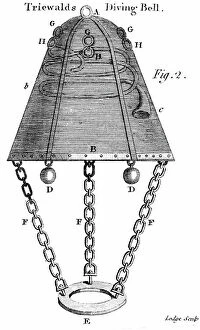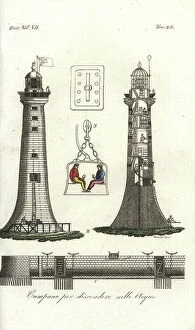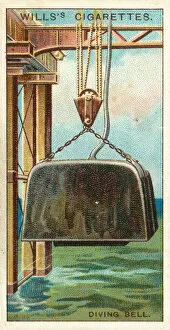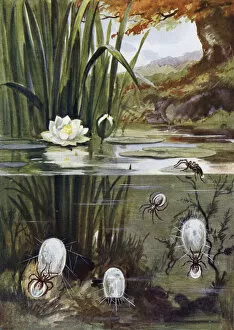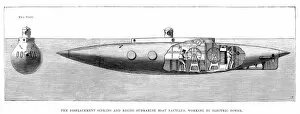Diving Bell Collection
The Hamburg Diving Bell, a remarkable invention from Germany in 1880
All Professionally Made to Order for Quick Shipping
The Hamburg Diving Bell, a remarkable invention from Germany in 1880, has been brought back to life through a digitally restored reproduction of an original from the 19th century. This chromolitho print captures the essence of this extraordinary diving apparatus. Centuries before its creation, explorers like Alexander were already venturing into the depths of the sea using primitive diving bells. In 1597-8, Alexander was lowered into the ocean in one such bell, as depicted in an intriguing ink drawing. The image transports us back to that moment when humanity first dared to explore beneath the waves. In later years, advancements were made to these underwater vessels. Spaldings improved Diving-Bell featured air barrels and allowed for even greater exploration beneath the surface. An engraving showcases this innovative design and highlights how technology evolved over time. The Thames Tunnel played a significant role in pushing diving bell technology forward. Engravings depict both its construction and usage during this monumental project. These images give us a glimpse into how divers risked their lives within these metal contraptions while contributing to engineering marvels. Not only did humans use diving bells for exploration; nature also had its own version – The Water Spider and Its Diving Bell is captured beautifully in a colorful lithograph. This fascinating creature constructs its own miniature vessel to navigate underwater realms with ease. As time went on, more sophisticated designs emerged like "Going down in a Diving Machine, " published in 1801 as a hand-colored engraving. This artwork provides insight into how people experienced subaquatic adventures during that era. One particular image stands out among all others - Alexander enclosed within a glass barrel submerged deep below the surface. A testament to human ingenuity and bravery, it symbolizes our relentless pursuit of knowledge about our watery world. Lastly, we have an unknown creator's depiction of another diving bell used during the construction of London's Thames Tunnel in 1878.



